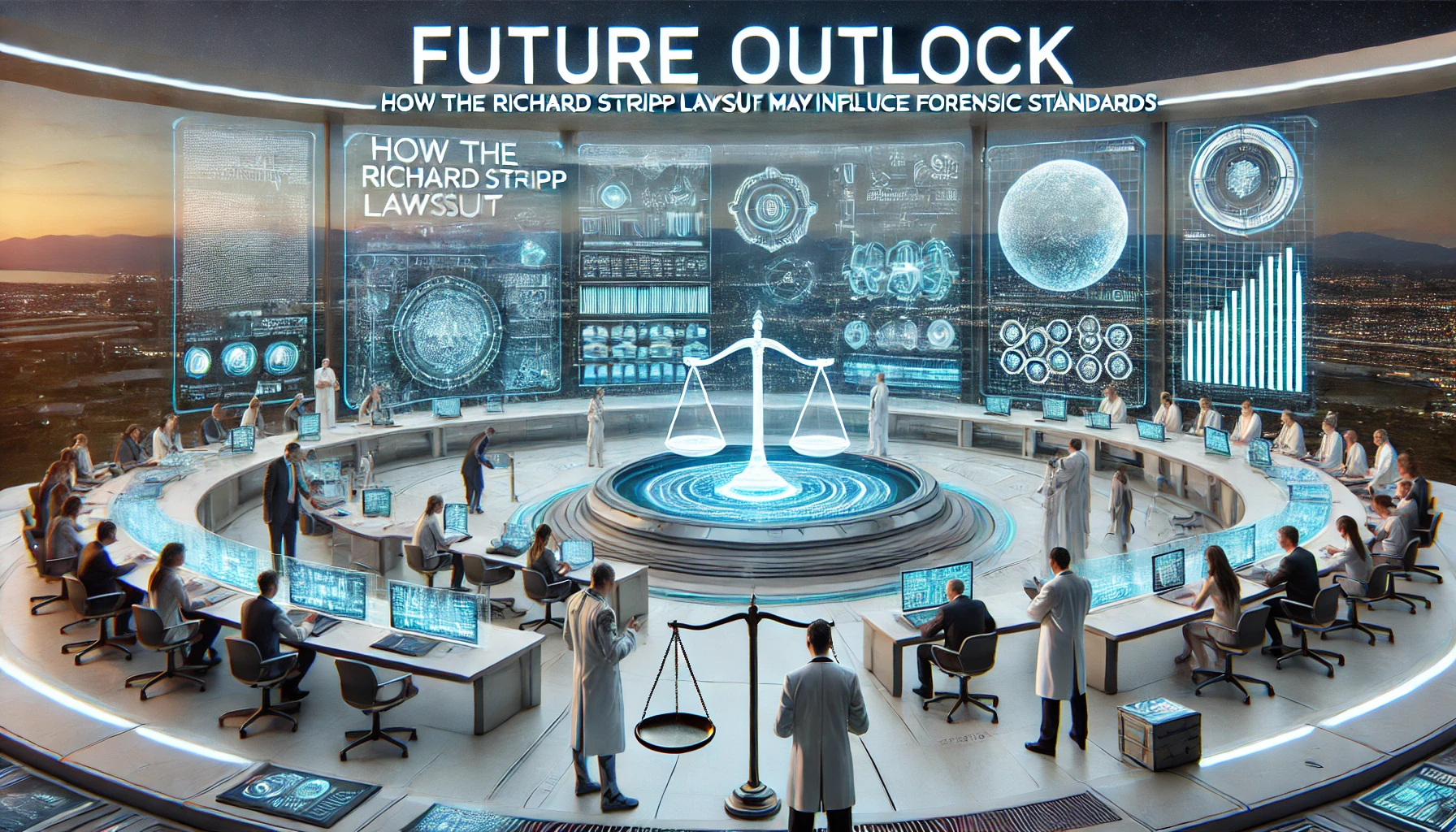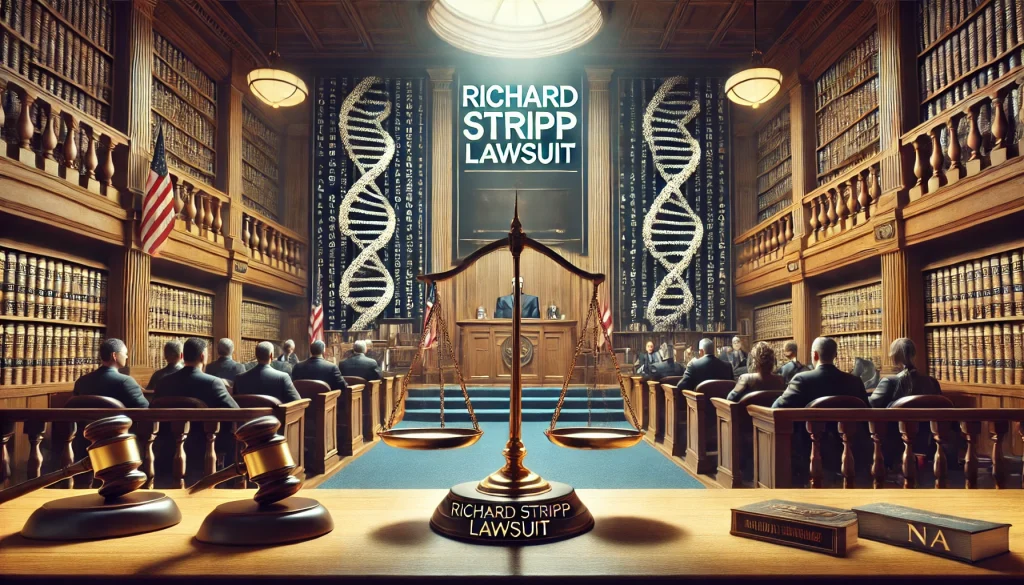As a prominent figure in forensic toxicology, Dr. Richard Stripp’s involvement in this legal case raises questions about the integrity of expert testimony and its role in judicial processes.
The case revolves around allegations that could have far-reaching consequences for ongoing and past legal proceedings involving his work. With his expertise frequently called upon in complex cases, the Richard Stripp lawsuit challenges the standards and accountability of professionals in forensic sciences.
Media coverage and public discourse surrounding the Richard Stripp lawsuit emphasize its potential to reshape perceptions of forensic expertise. As the legal process unfolds, the implications for scientific and legal collaborations remain a critical point of discussion.
Background of Dr. Richard Stripp and His Role in Forensic Toxicology
Dr. Richard Stripp is a highly regarded forensic toxicologist, known for his expertise in analyzing biological samples to uncover the presence of drugs, alcohol, and other substances. With a career spanning decades, he has contributed significantly to the fields of toxicology and forensic science.
Over the years, Dr. Stripp’s work has been pivotal in criminal and civil cases, where his analyses have influenced verdicts and legal outcomes. His methodologies have been widely taught and adopted in toxicological practices, underscoring his influence in the industry.
Beyond his professional achievements, Dr. Stripp has also been involved in educational programs, mentoring aspiring toxicologists and fostering advancements in forensic methodologies. His commitment to high standards in forensic science has been widely acknowledged.
However, the Richard Stripp lawsuit has brought this illustrious career under scrutiny. Questions about the validity of some of his findings have emerged, leading to a broader discussion about the responsibility and accountability of forensic experts.
His role in forensic toxicology remains a central point of discussion, as his work is critically analyzed in the wake of this lawsuit. The case sheds light on the fine line between scientific expertise and the judicial process.
Understanding the Richard Stripp Lawsuit: Expert Insights and Implications
The Richard Stripp lawsuit has become a focal point of debate in the forensic and legal communities. Experts have shared their perspectives on the challenges it presents and the lessons it offers. One prominent forensic analyst commented,
“Cases like this remind us that science must be precise, transparent, and unwavering in its integrity—especially when lives and verdicts are on the line.”
This lawsuit has also highlighted the broader implications for forensic toxicology. Legal professionals emphasize the ripple effect such cases can have on judicial systems. A defense attorney reflected,
“The Richard Stripp lawsuit challenges us to think critically about how we vet expert testimony. It’s not just about one professional—it’s about the entire system’s ability to ensure justice.”
Discussions surrounding the lawsuit have revealed its emotional and professional toll on those involved. A forensic toxicologist remarked,
“This is a pivotal moment for our field. We must use it as an opportunity to improve, to reinforce the trust that courts and the public place in forensic evidence.”
The insights shared by experts paint a picture of a profession at a crossroads, one that must evolve in the face of increasing scrutiny while holding firm to its commitment to justice and truth.
The Allegations in the Richard Stripp Lawsuit
The Richard Stripp lawsuit primarily revolves around allegations concerning the accuracy and reliability of his toxicology reports. Critics claim that certain analyses conducted under his supervision may have been flawed or incomplete.
One of the core issues is the alleged misrepresentation of evidence in some legal cases. The lawsuit argues that errors in his reports might have impacted verdicts, raising concerns about justice and due process.
Key Allegations:
- Possible procedural lapses in sample analysis.
- Alleged bias in interpreting toxicological data.
- Questions about the chain of custody in certain cases.
These allegations have sparked debates about forensic accountability. While supporters of Dr. Stripp highlight his contributions, detractors emphasize the need for stricter oversight.
The Richard Stripp lawsuit is also raising concerns about systemic issues in forensic toxicology. It underscores the importance of transparency and rigorous validation in expert testimonies, especially in high-stakes legal matters.
Legal Proceedings and Developments in the Richard Stripp Case

The legal proceedings in the Richard Stripp lawsuit began with the filing of claims questioning his forensic practices. The initial phase focused on gathering evidence and testimonies from affected parties.
As the case unfolded, both sides presented extensive documentation. Proponents of Dr. Stripp defended his methodologies as standard practice, while the plaintiffs highlighted discrepancies in his reports.
Timeline of Key Developments:
| Date | Event |
| Early 2023 | Lawsuit filed alleging professional misconduct. |
| Mid-2023 | Evidence review and preliminary hearings begin. |
| Late 2023 | Expert witnesses provide insights on forensic procedures. |
| Early 2024 | Scheduled trial proceedings and further investigations. |
The Richard Stripp lawsuit is expected to take several months to conclude, given its complexity. The case’s outcome could establish new precedents for evaluating forensic testimony.
Legal experts emphasize that the case highlights the delicate balance between scientific interpretation and legal standards, making it a focal point for reform discussions.
Impact of the Richard Stripp Lawsuit on Forensic Toxicology Practices
The Richard Stripp lawsuit has sent shockwaves through the forensic community, prompting a re-evaluation of existing practices. Toxicology labs are increasingly scrutinizing their procedures to avoid similar controversies.
One major impact has been the heightened emphasis on peer reviews and cross-validation of toxicological findings. Institutions are implementing stricter protocols to ensure data integrity and accuracy in expert testimonies.
Key Changes Observed:
- Adoption of advanced technologies for error reduction.
- Enhanced training for forensic toxicologists.
- Stricter adherence to chain-of-custody procedures.
While the lawsuit has raised concerns, it has also provided an opportunity for the forensic community to improve standards. Some professionals argue that the case has underscored the need for better collaboration between scientific experts and the legal system.
The Richard Stripp lawsuit is likely to influence future educational curriculums for forensic scientists, ensuring they are better equipped to navigate the challenges of legal accountability.
Reactions from the Scientific Community to the Richard Stripp Allegations
The scientific community has had mixed reactions to the Richard Stripp allegations, with many expressing concern over the potential impact on the credibility of forensic toxicology. Experts have debated whether the issues raised reflect personal shortcomings or broader systemic challenges.
Some forensic professionals have defended Dr. Stripp, citing his contributions to the field and emphasizing the complexity of toxicological interpretations. They argue that errors, if proven, may be anomalies rather than indicative of widespread negligence.
On the other hand, critics have called for stricter oversight and better validation protocols in forensic labs. They argue that the Richard Stripp allegations highlight vulnerabilities in the justice system that depend heavily on expert testimonies.
To address these concerns, several organizations have initiated discussions about updating best practices in forensic toxicology. This includes proposals for more rigorous training, certifications, and peer reviews.
The Richard Stripp lawsuit has sparked an important dialogue about balancing scientific expertise with accountability, pushing the forensic community to reevaluate its standards and methodologies.
Media Coverage and Public Perception of the Richard Stripp Lawsuit

The Richard Stripp lawsuit has garnered widespread media attention, with outlets covering the case from various angles. Initial reports focused on the allegations and their implications for past and ongoing legal cases.
Public perception has been divided. While some view the lawsuit as a necessary step toward ensuring justice, others perceive it as a potential overreaction that undermines trust in forensic science. Media narratives have played a key role in shaping these opinions.
Media Coverage Focus Areas:
- Alleged inconsistencies in Dr. Stripp’s work.
- Testimonies from legal experts and affected parties.
- Broader implications for forensic toxicology.
Social media discussions about the Richard Stripp lawsuit have amplified public scrutiny. Some commentators have raised questions about systemic issues in the judicial reliance on scientific experts, while others have focused on Dr. Stripp’s professional achievements.
The extensive media coverage has also led to increased awareness about the role of forensic toxicology in the justice system. This attention could potentially drive reforms in how expert witnesses are vetted and their findings evaluated.
Potential Consequences for Legal Cases Involving Dr. Richard Stripp’s Testimonies
The Richard Stripp lawsuit has cast a shadow on legal cases where his testimony played a pivotal role. If allegations against him are substantiated, it could lead to retrials and appeals in cases where his toxicology reports influenced the verdict.
Legal experts have expressed concern that the lawsuit might undermine public confidence in forensic evidence. Judges and attorneys may now approach expert testimonies with heightened scrutiny to ensure fairness and reliability.
Potential Outcomes:
- Review of past cases involving Dr. Stripp’s analyses.
- Increased scrutiny of forensic experts in future trials.
- Calls for improved standards in toxicological reporting.
Some defense attorneys have already begun using the Richard Stripp allegations to question the credibility of prosecutions in cases where his findings were integral. This could lead to prolonged legal battles and additional strain on the justice system.
While the lawsuit has raised valid concerns, it also highlights the need for reforms to ensure that expert testimonies are based on sound science and remain free of bias. The ripple effects of this case are likely to influence the legal landscape for years to come.
Analysis of the Evidence Presented in the Richard Stripp Legal Proceedings
The evidence presented in the Richard Stripp legal proceedings has been a focal point of the case, with both sides providing detailed documentation to support their claims. Plaintiffs have emphasized discrepancies in toxicology reports, while Dr. Stripp’s defense has highlighted procedural challenges inherent to the field.
A significant portion of the evidence involves case studies where Dr. Stripp’s findings were critical to legal decisions. Questions about sample integrity, data interpretation, and procedural compliance have been raised.
Table: Key Evidence Categories in the Lawsuit
| Category | Details |
| Toxicology Reports | Alleged inconsistencies in chemical analyses. |
| Expert Testimonies | Opinions from forensic and legal experts on the methodology. |
| Procedural Documentation | Review of sample handling and chain-of-custody records. |
| Case Study Analysis | Impact of findings on past verdicts and appeals. |
The Richard Stripp lawsuit has brought attention to the complexity of interpreting forensic evidence, where minor errors can have significant legal consequences.
Legal analysts suggest that this case will serve as a critical example of how evidence should be scrutinized and validated in forensic toxicology, ensuring fairness in judicial processes.
Expert Opinions on the Richard Stripp Lawsuit and Its Broader Implications
Experts in forensic science and law have shared diverse opinions on the Richard Stripp lawsuit, reflecting the complexity of the case. While some see it as a warning about the fallibility of forensic processes, others view it as an opportunity for reform.
Several toxicologists have defended Dr. Stripp, pointing out the inherent challenges in interpreting toxicological data. They argue that no forensic expert is immune to errors, especially in cases involving complex substances or ambiguous evidence.
Conversely, legal analysts highlight the broader implications of the lawsuit. They believe it could undermine public trust in forensic testimony, prompting courts to demand higher standards for expert evidence.
The Richard Stripp lawsuit has also inspired discussions about how expert witnesses are trained and vetted. Institutions are revisiting their certification processes to ensure that such cases remain exceptions, not the norm.
Ultimately, this case underscores the need for collaboration between legal and scientific communities, fostering better understanding and clearer standards for forensic practices.
Comparative Study: The Richard Stripp Case and Similar Forensic Controversies
The Richard Stripp case is not the first to challenge the reliability of forensic evidence. Similar controversies have arisen in the past, each highlighting weaknesses in the intersection of science and law.
Cases like the Brandon Mayfield fingerprint error or the Annie Dookhan lab scandal also shook public confidence in forensic methods. These incidents revealed systemic issues, such as inadequate training, lack of oversight, and pressure to deliver results quickly.
Table: Comparative Overview of Notable Forensic Controversies
| Case | Key Issue | Impact |
| Brandon Mayfield (2004) | Misidentified fingerprints | Highlighted flaws in forensic accuracy. |
| Annie Dookhan (2012) | Falsified lab results | Led to case dismissals and system reforms. |
| Richard Stripp (2023–Present) | Alleged errors in toxicology reports | Raised questions about forensic accountability. |
In comparison, the Richard Stripp lawsuit is unique due to its focus on toxicology, a field with inherent scientific complexities. Lessons from these cases emphasize the importance of rigorous validation, peer reviews, and transparency in forensic work.
Analyzing such controversies offers valuable insights into how the justice system can better incorporate scientific expertise without compromising its reliability.
Future Outlook: How the Richard Stripp Lawsuit May Influence Forensic Standards

The Richard Stripp lawsuit is likely to have long-term effects on forensic standards, sparking widespread reforms in the way toxicological evidence is collected, analyzed, and presented in court.
One immediate impact could be the introduction of stricter protocols for peer reviews in forensic labs. Enhanced scrutiny will help identify errors early, ensuring greater reliability in toxicology reports.
Predicted Reforms:
- Standardized training for forensic toxicologists.
- Mandatory audits of high-profile cases involving expert testimonies.
- Adoption of advanced technologies to minimize human error.
In addition, the lawsuit may lead to changes in how courts evaluate expert witnesses. Judges and attorneys could demand higher levels of transparency and more robust methodologies.
The case also has implications for education, as academic institutions may integrate lessons from the Richard Stripp lawsuit into their curriculums to better prepare future forensic professionals.
Legal Perspectives: Understanding the Charges and Defense in the Richard Stripp Case
The Richard Stripp case is built around charges of alleged negligence in toxicological analyses, with claims that some reports may have influenced legal outcomes unfairly. These charges challenge both his professional conduct and the systemic processes supporting forensic science.
From a legal standpoint, the plaintiffs argue that procedural errors and inconsistencies in Dr. Stripp’s reports may have led to wrongful convictions or unjust verdicts. This raises questions about accountability in forensic testimony.
Dr. Stripp’s defense team, however, emphasizes the complexity of toxicology as a field. They argue that any perceived errors were within acceptable scientific margins and that his methodologies align with established standards.
Key Legal Questions:
- Were Dr. Stripp’s toxicology reports scientifically valid?
- Did procedural lapses occur, and if so, were they intentional or systemic?
- How should courts address the fallout from contested expert testimonies?
The Richard Stripp lawsuit thus delves into broader legal and ethical issues, such as the role of expert witnesses in ensuring justice and the safeguards needed to protect their credibility.
Lessons Learned from the Richard Stripp Lawsuit for Forensic Professionals
The Richard Stripp lawsuit offers valuable lessons for forensic professionals, emphasizing the need for precision, accountability, and transparency in their work.
One key takeaway is the importance of adhering to standardized procedures. Ensuring the integrity of sample collection, analysis, and reporting can help prevent errors and build trust in forensic practices.
Forensic experts are also reminded of the ethical responsibilities tied to their roles. The Richard Stripp case highlights the potential consequences of lapses, not just for the individuals involved but for the entire justice system.
Practical Lessons:
- The value of peer reviews and collaborative analysis.
- The importance of clear communication between scientists and legal professionals.
- The need for ongoing education and adaptation to emerging forensic challenges.
Ultimately, the lawsuit reinforces the idea that forensic science must continually evolve to meet both scientific and legal demands. By learning from this case, professionals can contribute to a more reliable and ethical justice system.
Conclusion
The Richard Stripp lawsuit has highlighted critical challenges at the intersection of forensic science and the legal system. It underscores the importance of maintaining accuracy, accountability, and ethical standards in toxicological analyses, especially when they play a pivotal role in judicial decisions.
This case serves as a reminder of the complexities and responsibilities inherent in forensic work. It has sparked valuable conversations about reforming forensic practices, improving expert training, and fostering transparency to rebuild trust in expert testimony.
As the implications of the Richard Stripp lawsuit unfold, it offers an opportunity for the forensic and legal communities to collaborate on establishing higher standards. By addressing the systemic issues raised, both fields can work towards ensuring that science continues to serve justice effectively and fairly.

